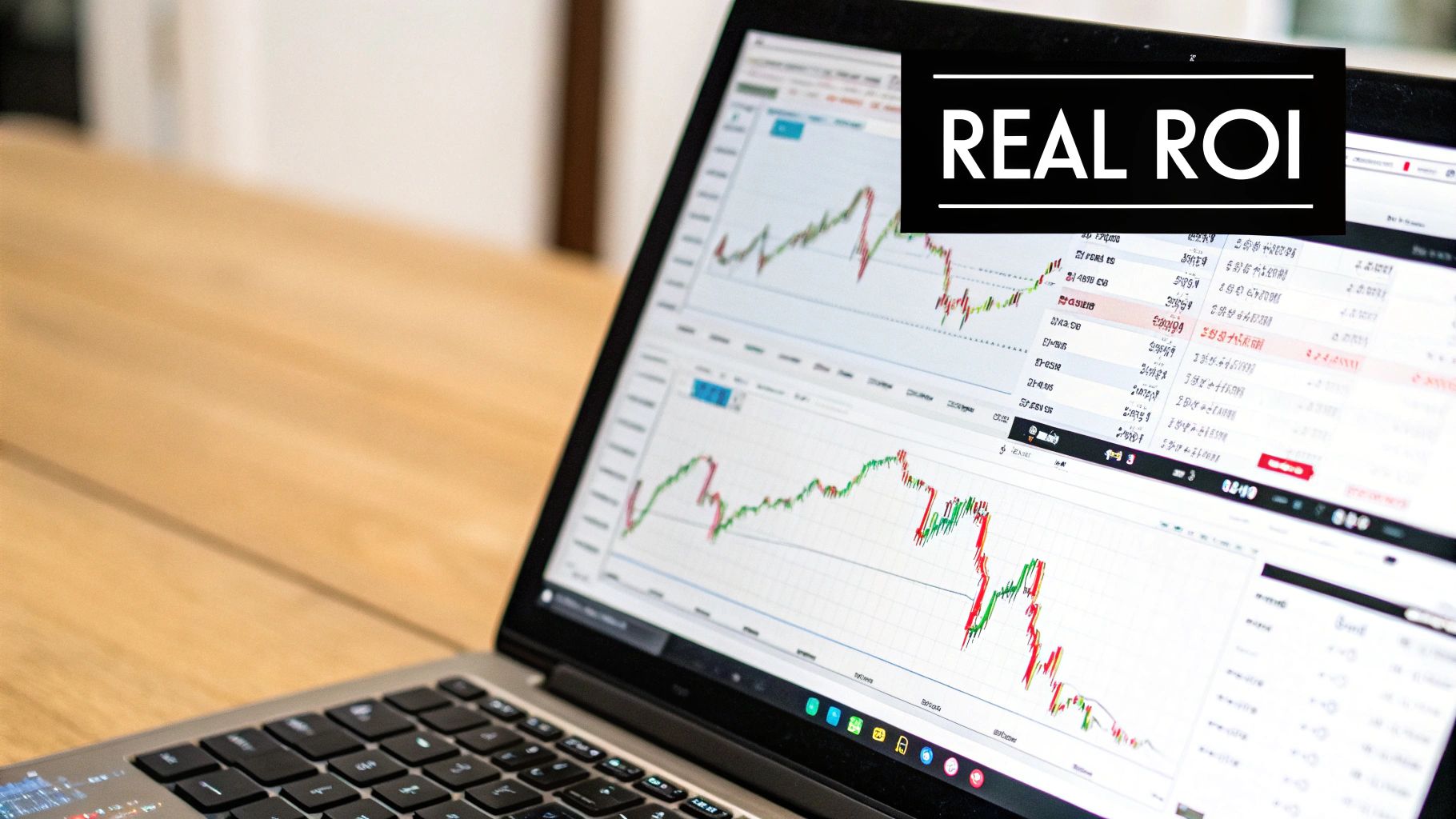When it comes to measuring your performance as a trader, few metrics are as clear and powerful as Return on Investment, or ROI. It’s the ultimate bottom line, telling you whether your hard work and capital are paying off. We all face the struggle of trying to figure out what’s working and what isn’t; ROI is the tool that brings clarity.
The formula itself is straightforward: (Net Profit / Cost of Investment) x 100. This calculation gives you a simple percentage that tells you how efficiently you put your capital to work on any given trade or over a period of time.
What ROI Really Tells You About Your Trading
Before you get lost in the numbers, it’s worth taking a step back to understand what ROI actually is. It’s more than just a performance metric; it’s a compass for your entire trading strategy. In a world full of complex data points and market noise, ROI cuts straight to what matters: are you making money relative to the capital you’re risking?
Think about it. You might have a quick, profitable flip on a meme stock and a slow-burn win on a blue-chip that took months to play out. How do you compare them? ROI gives you that common ground, a standardized way to measure the efficiency of any trade, regardless of its duration or style. Without it, you’re just guessing which strategies are truly building your account. It’s a journey of a thousand trades, and ROI helps you take each step with purpose.
This infographic is a great way to visualize ROI as a directional tool for your trading decisions.

As the image shows, ROI acts as your north star, guiding you toward what’s working and steering you away from strategies that are just draining your capital.
The Building Blocks of Accurate ROI
For this compass to point true, you have to be brutally honest about the numbers you plug into it. The two core parts of the ROI formula — “Net Profit” and “Cost of Investment” — are where many traders trip up. Getting this wrong doesn’t just skew your numbers; it can hide a failing strategy.
Let’s break down exactly what these mean in the real world.
The Core Parts of the ROI Formula
| Component | What It Really Means | Simple Example |
|---|---|---|
| Net Profit | This isn’t just your selling price minus your buying price. It’s the final profit after all costs are deducted. Think commissions, platform fees, and any other trading expenses. | You buy a stock for $1,000 and sell it for $1,100. Your gross profit is $100, but you paid $5 in fees. Your Net Profit is $95. |
| Cost of Investment | This is the total amount of capital you had to lock up to open and maintain the position. It’s the full sum of money you put on the line. | For that same trade, the total cash required to make the purchase was $1,000. That’s your Cost of Investment. |
Getting these two components right is non-negotiable for accurate analysis. Overlooking small fees gives you an inflated, and dangerous, sense of success.
The discipline to consistently and honestly track every variable is what separates successful, long-term traders from those who chase fleeting wins. It’s a habit that builds a foundation for sustainable growth.
By understanding these details, you transform a simple calculation into a powerful tool for self-assessment. Nail this from the beginning, and you’ll build the clarity needed to analyze your performance like a pro.
Getting Your Hands Dirty with the ROI Formula
Theory is one thing, but actually applying the formula to real trades is where the rubber meets the road. It’s a classic trader frustration: you think you’ve booked a nice profit, but the numbers in your account don’t quite add up. Why? Because of all the small, easy-to-forget costs that chip away at your gains.
Let’s walk through a couple of practical, common scenarios to get this calculation down to a science.

Making this a habit is the only way to see how your strategy is really performing, not just the headline number on a winning ticket.
Example 1: The Tech Stock Trade
Let’s say you spot an opportunity and buy 10 shares of a tech company at $150 per share. That’s an initial outlay of $1,500. The stock has a good run over a few months, and you decide it’s time to sell all 10 shares at $180 each, bringing in $1,800.
Looks like a $300 profit, right? Not so fast. We need to factor in the costs.
- Initial Cost: $1,500
- Commission to Buy: $5
- Commission to Sell: $5
Your Total Cost of Investment isn’t just the purchase price; it’s $1,500. This is the capital you put at risk. The fees come out of the profit. Your Net Profit is your gross gain ($1,800 – $1,500 = $300) minus your total fees ($5 + $5 = $10), which comes out to $290. That $10 difference might seem small, but it’s crucial. For a deeper dive, check out our guide on calculating trading profit accurately.
Now, we plug these real numbers into the ROI formula:
($290 Net Profit / $1,500 Cost of Investment) x 100 = 19.33% ROI.
Example 2: The Cryptocurrency Flip
Alright, let’s switch gears to crypto. You decide to put $500 into a trending coin. The market is wild, and a week later, your position shoots up to $650. Time to cash out. But crypto platforms have their own fee structures.
- Initial Cost: $500
- Platform Fee (1% on buy): $5
- Platform Fee (1% on sell): $6.50
Your total fees are $5 + $6.50 = $11.50. Your Net Profit is ($650 – $500) – $11.50 = $138.50.
So, what’s the ROI?
($138.50 Net Profit / $500 Cost of Investment) x 100 = 27.7% ROI.
These examples make one thing crystal clear: ignoring even tiny fees will skew your results. A disciplined, long-term approach to including every single cost is the only way to get a true picture of your performance and make smart decisions about your strategy.
Remember, understanding performance is all about context. In 2021, for example, the MSCI EAFE Index for international stocks returned about 14.82%. Meanwhile, some emerging markets saw returns closer to 41.30%. It’s a good reminder that different markets produce wildly different results. There’s no “guaranteed profit,” only the disciplined application of a well-measured strategy.
Comparing Apples to Oranges With Annualized ROI
A simple ROI calculation is a great place to start, but it has one massive blind spot: it completely ignores time.
Think about it. Is a 20% return you bagged in three weeks better than a 35% return that took two long years to materialize? The bigger number might catch your eye, but the first trade was way more efficient with your capital.
This is a classic problem for traders trying to weigh different strategies against each other. You end up comparing apples to oranges, making it nearly impossible to know where to really focus your efforts. This is exactly where annualized ROI becomes one of the most powerful tools in your analytical toolkit for building a long-term perspective.
Leveling the Playing Field
Annualized ROI standardizes your returns into a yearly equivalent. It answers the crucial question, “If I could sustain this performance over a full year, what would my return look like?” This gives you a true, direct way to compare trades, no matter how long you held them.
Let’s see how this works in practice.
Imagine you pulled off a 10% ROI on a trade you were in for just 60 days. The formula to annualize this looks a bit complex at first, but the idea behind it is straightforward. You’re just projecting that 60-day performance across a full 365-day year.
Annualized ROI = ((1 + ROI) ^ (365 / Holding Period in Days)) – 1
Let’s plug our numbers into that formula:
((1 + 0.10) ^ (365 / 60)) – 1 = ~77.8% Annualized ROI
All of a sudden, that “modest” 10% gain looks incredibly powerful. This calculation is a game-changer for building long-term discipline. It stops you from chasing those flashy, high-percentage returns that often come with unsustainable risks. It’s a key metric that works hand-in-hand with other performance measures, like your profit factor.
Getting used to thinking in annualized terms is also vital when you zoom out and look at market cycles. The back-and-forth between U.S. and international stocks, for example, has moved in cycles for decades. Since 1975, periods of U.S. outperformance have averaged over eight years. Understanding the long-term, annualized efficiency of your strategy is essential to navigating these larger trends. You can discover more insights about market cycles on hartfordfunds.com.
Costly ROI Mistakes Most Traders Make

Calculating your return on investment should be straightforward, but it’s dangerously easy to get wrong. Many traders, especially early on, fall into the same traps that give them a completely warped view of their performance. We’ve all been there. These aren’t just minor math slip-ups; they’re bad habits that can hide a failing strategy and make you double down on poor decisions.
One of the biggest pitfalls is overlooking the “little” costs. We’ve all had that trade that looks like a solid winner on the chart, but the final number that hits the account is weirdly disappointing. This is what happens when we forget about the silent profit killers.
- Trading Fees: The commission your broker takes for every single buy and sell order.
- Platform Commissions: Some platforms will tack on their own percentage-based fees.
- Taxes: Capital gains taxes can take a huge bite out of your net profit. Ignoring them gives you a false sense of security until tax season.
These expenses add up fast and can easily turn a profitable trade into a breakeven or even a loss. Getting disciplined about subtracting every single cost is non-negotiable if you want an honest look at your trading.
The Trap of Selective Memory
Another massive mistake is purely psychological. It’s just human nature to celebrate our wins and quietly shove the losses to the back of our minds. But “cherry-picking” only your successful trades paints a dangerously optimistic — and entirely false — picture of your abilities. You might feel great about a few big winners, but a real ROI calculation has to include every single trade, especially the painful losses.
A trader’s journal is their source of truth. If you only log the wins, you’re not analyzing your performance; you’re just writing fiction. The goal is brutal honesty, as that’s the only path to long-term improvement.
This complete picture gives you critical context and shows you how different approaches are actually performing. For instance, while the S&P 500 returned a whopping 26.29% in 2023, high-grade bonds offered much steadier, though smaller, returns. Ignoring your losing trades is like trying to analyze the market while ignoring an entire asset class. Learn more about historical stock and bond returns on carry.com.
How a Trading Journal Automates Your ROI Analysis
Let’s be honest, manually calculating the return on investment for every single trade is a nightmare. It’s a surefire path to burnout and, worse, costly mistakes. We’ve all been there — buried in spreadsheets, questioning every fee calculation, and completely losing sight of the big picture. This is exactly why a professional trading journal is a non-negotiable tool for any serious trader.
Modern journals automate all those tedious calculations, giving you instant, precise ROI data without any of the manual grind. But this isn’t just about saving time. It’s about shifting your focus from being a bookkeeper to a high-level strategist. When the journal handles the math, you’re free to spend your energy where it matters most: finding the patterns that define your trading performance.
Beyond Basic Calculations
A great trading journal does more than just spit out a number. It turns your ROI from a simple score into a powerful diagnostic tool. By logging key data points with each trade, you start building a rich dataset that reveals what’s really driving your results. Imagine being able to filter your entire trade history with just a single click.
This screenshot from TradeReview is a perfect example of what I mean. You can instantly see your performance metrics without touching a calculator.
The dashboard gives you that immediate, at-a-glance overview of your P&L, win rate, and return metrics. It turns raw, messy data into clear, actionable insights.
Suddenly, you’re not just looking at your overall ROI. You can start asking — and answering — much deeper questions about your strategy.
- By Strategy: Is my ROI on scalping trades outperforming my swing trades?
- By Asset Class: Am I genuinely better at trading tech stocks or is my edge in commodities?
- By Time of Day: Is my ROI consistently higher during the morning session versus the afternoon lull?
This level of detail lets you double down on what’s working and be ruthless about cutting what isn’t. You move from guessing to knowing, which is the bedrock of disciplined, long-term trading success.
The real value of an automated journal isn’t just the numbers it calculates. It’s the strategic questions it empowers you to ask and answer. It’s the difference between just tracking data and actually using that data to make better decisions.
Of course, for traders who prefer a more hands-on approach, you can still build a robust system from the ground up. If that sounds like you, check out our guide on creating a trading journal in Excel. It lays out all the foundational principles for effective trade logging.
Ultimately, whether you build your own system or use a dedicated tool, the goal is the same: create a system that brings consistency and clarity to your trading.
Have Questions About ROI? Let’s Clear Them Up
Even once you have the formulas down cold, questions always pop up when you start applying them to your own trades. It’s one thing to see the math in an example, but it’s another thing entirely when your own capital is on the line.
Let’s walk through some of the most common questions traders ask. Think of this as a quick FAQ to help you build the discipline needed for long-term, consistent performance.
What’s a “Good” ROI in Trading, Anyway?
This is the million-dollar question, isn’t it? But the honest answer is: there’s no single magic number. What’s considered a “good” ROI is completely relative to your strategy, risk tolerance, and even the assets you trade. Chasing someone else’s advertised returns is a recipe for frustration.
A high-frequency day trader might be ecstatic with a consistent 1% daily return, which would annualize into a phenomenal number (if sustainable). On the other hand, a long-term investor holding blue-chip stocks might be perfectly happy aiming for an 8-10% annual return, which is right in line with historical market averages.
The best way to think about it is to benchmark your performance against your own goals and past results. Forget the unverified claims you see on social media. Your ROI is your personal scorecard. The goal is long-term, sustainable growth, not overnight riches.
How Do I Calculate ROI on a Trade That Is Still Open?
When you calculate the return on a position you haven’t closed yet, you’re looking at your “unrealized” ROI. The process is exactly the same as for a closed trade, but with one small difference: instead of the final sale price, you just use the asset’s current market price.
Doing this gives you a real-time snapshot of how your trade is performing. Just remember that this number will constantly change with the market until you officially exit the position and “realize” the actual gain or loss.
Can My ROI Be Negative? What Does That Mean?
Absolutely. A negative ROI simply means you lost money on that particular investment. It happens when your total cost to enter the trade was greater than what you got back when you sold it. While no trader enjoys seeing red, it’s an unavoidable part of the game. Every single trader, no matter how experienced, takes losses.
In fact, embracing and analyzing your losses is one of the most important things you can do. Those negative numbers give you invaluable data about which strategies aren’t working, what market conditions trip you up, or where your own psychology is costing you money. Tracking negative ROI is just as critical as tracking your wins for long-term improvement.
Ready to stop guessing and start analyzing? TradeReview offers a powerful, free trading journal that automates your ROI calculations and gives you the performance analytics you need to make smarter, data-driven decisions. Ditch the spreadsheets and see your trading performance with total clarity.


